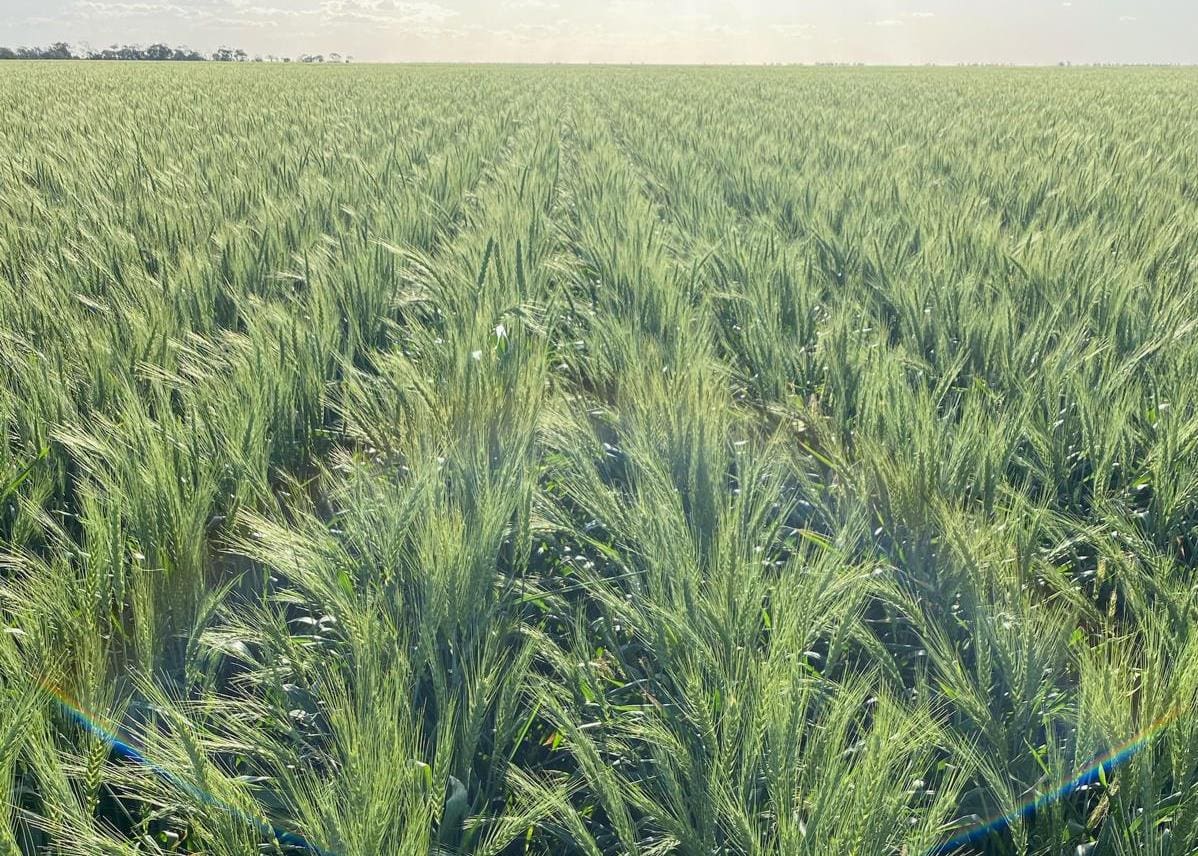
Wheat crops like this one at Burren Junction in north-west NSW are a few weeks away from harvest and on track for above-average yields. Photo: CHS Broadbent
BARLEY values have found support from this week’s Saudi tender and some short covering in the northern market, while export demand for early shipment wheat is being seen in all active port zones.
The northern market for prompt wheat and barley remains scrappy as small amounts trade at diverse values, and growers are paying attention to rising premiums for high-protein new-crop wheat.
| This week | Last week | Change | |
| Barley Downs early Oct | $325 | $335 | Down |
| Barley Downs Jan | $255 | $250 | Up |
| Barley Melbourne Oct | $250 | $235 | Up |
| Barley Melbourne Jan | $250 | $235 | Up |
| Wheat Downs early Oct | $365 | $305 | Up |
| Wheat Downs Jan | $295-$300 | $283 | Up |
| Wheat Melbourne Oct | $315 | $305-$310 | Up |
| Wheat Melbourne Jan | $300 | $290 | Up |
| Sorghum Downs Oct | $285 | $305 | Down |
| Sorghum Downs Mar-Apr | $285 | $295 | Down |
Table 1: Indicative delivered grain prices in AUD per tonne.
Shoulder season arrives
While the inverse between current and new-crop has disappeared in the southern barley market, and steadied at around $15 per tonne on wheat, a slow and patchy start to harvest is keeping it alive in the north.
Trade sources are reporting the second-half October market for wheat and barley as being the shoulder between prompt and new-crop values, and transacting more volume than nearby.
Delta Grain Marketing broker Tom Vanzella said prices seen in the latest Saudi tender and some nearby demand had been supportive of barley values in this shoulder period.
“There’s a fair bit of interest in what’s on farm,” Mr Vanzella said.
“With the Saudi business, the barley market has been quite firm.”
Confidence that barley harvesting, and some selling straight off the header, will be under way on the north-west plains of New South Wales by mid-October have cash prices trading at only a slight premium to new-crop.
“Everyone’s sweating on this big crop that’s coming at us.”
The last parcels of current-crop barley to be found in north-west NSW are selling for immediate pick-up at up to $300-$310/t on farm to go to a handful of local feedlots which cannot wait for harvest pressure to soften the market.
“Most feedlots are happy to wait until harvest starts, especially seeing as a lot of them are uncertain about what sort of numbers they’ll have on over summer,” one buyer said.
“Cattle are getting dearer, not cheaper.”
Wheat in demand
On wheat, Delta Grain Marketing general manager Mick Parry said multigrade contract values had risen by around $30/t since early September, and $10/t in the past week alone.
“Growers have sold a good deal of multigrade already, and they’ll probably sell some and store some of what’s left at harvest.”
With grain being accumulated for vessels loading from late November onward, plus some domestic demand, the southern market has also rallied.
“Southern NSW is up $20/t in the past three weeks.”
Mr Parry said multigrade prices were around $40-$50/t above comparable 2016 levels as NSW gears up to harvest a near-record volume of winter crop.
“Prices on wheat are just a bit above the long-term average, and canola is $75/t over the long-term average, so growers aren’t unhappy about selling at these levels.
“Protein spreads are starting to move a bit, and if there are any problems with weather, with the forecast for a wet spring, they will increase, and exporters will be rushing to buy the northern protein wheat.”
In Queensland, up-country consumers are paying enough to pull even high-protein wheat into the local feed market.
“There’s no premium for Prime Hard on the Downs, and the protein spread we saw years ago are dwindling because we don’t have that market into Asia for early high-protein wheat like we used to,” one trader said.
“They can get what they need at 12.5-13 per cent protein from the Black Sea around this time of year.”
Dry week for north
Only a few millimetres of rain are forecast for cropping areas in northern NSW and Queensland in the coming week.
This will allow harvest to get going or advance in the earlier areas, and crops to start ripening in the later ones.
Signs from the export market point to high wheat protein being rewarded once harvest rolls into the southern half of NSW, particularly if the crop comes home with a wet sail.
In the sorghum market, Queensland’s first and possibly only bulk shipment is currently loading in Gladstone, and prices appear to have softened with this business and nearby domestic demand now covered.



HAVE YOUR SAY